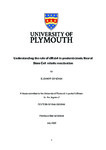Understanding the role of dMob4 in postembryonic Neural Stem Cell mitotic reactivation
| dc.contributor.supervisor | Barros, Claudia | |
| dc.contributor.author | Gonzaga, Eleanor | |
| dc.contributor.other | Faculty of Health | en_US |
| dc.date.accessioned | 2020-10-07T11:34:45Z | |
| dc.date.available | 2020-10-07T11:34:45Z | |
| dc.date.issued | 2020 | |
| dc.identifier | 10473951 | en_US |
| dc.identifier.uri | http://hdl.handle.net/10026.1/16489 | |
| dc.description | Gil-Ranedo, J, Gonzaga, E, Jaworek, KJ, Berger, C, Bossing, T and Barros, CS.(2019). STRIPAK Members Orchestrate Hippo and Insulin Receptor Signalling to Promote Neural Stem Cell Reactivation. Cell Rep 27, 2921-2933 e2925 10.1016/j.celrep.2019.05.023. | en_US |
| dc.description.abstract |
Brain homeostasis supports cognition and neural plasticity, the brains’ ability to adapt to its environment throughout life. These processes rely on replenishment from stem cells in the brain, termed Neural Stem Cells (NSCs). In the adult brain, most NSCs exist in a quiescent state and must activate to generate new neural progeny. Understanding how NSCs balance quiescence and activation is crucial for the development of brain repair therapies. Drosophila NSCs, termed neuroblasts (NBs), are a model to study reactivation from quiescence. The Hippo and Insulin pathways were reported to promote NB quiescence and reactivation, respectively. However, the underlying mechanisms are not fully understood. This thesis describes my investigation of Monopolar spindle-one-binder 4 (Mob4), a member of the highly conserved Striatin-Interacting Phosphatase and Kinases (STRIPAK) complex, identified by our laboratory in a transcriptome analysis comparing quiescent and reactivating NBs. I show that Mob4 is upregulated in reactivating NBs, and its loss prevents NB reactivation. Mob4 overexpression accelerates reactivation, which can be mimicked by human MOB4 expression, suggesting a conserved function. I provide evidence that Mob4 acts primarily cell-autonomously in pNBs and demonstrate that inactivation or activation of Hippo and Insulin signalling, respectively, in mob4 pNBs can restore reactivation. Finally, I show that Mob4 cooperates with another STRIPAK member, Cka, to promote pNB reactivation, whereas PP2A phosphatase with its regulatory subunit Widerborst maintains NB quiescence. My results, together with data from our group, lead to a model whereby Mob4 and other STRIPAK members assist the coordination of Insulin and Hippo pathways to promote NB reactivation. Given the evolutionary conservation of the molecules investigated, my findings may also be relevant to mammalian NSCs and other stem cells. | en_US |
| dc.language.iso | en | |
| dc.publisher | University of Plymouth | |
| dc.subject.classification | PhD | en_US |
| dc.title | Understanding the role of dMob4 in postembryonic Neural Stem Cell mitotic reactivation | en_US |
| dc.type | Thesis | |
| plymouth.version | publishable | en_US |
| dc.identifier.doi | http://dx.doi.org/10.24382/1073 | |
| dc.rights.embargoperiod | No embargo | en_US |
| dc.type.qualification | Doctorate | en_US |
| rioxxterms.version | NA |
Files in this item
This item appears in the following Collection(s)
-
01 Research Theses Main Collection
Research Theses Main


